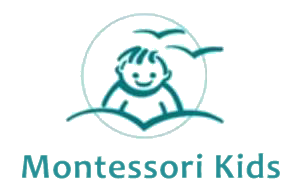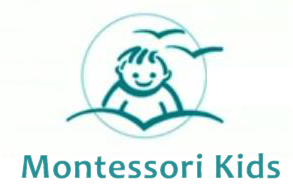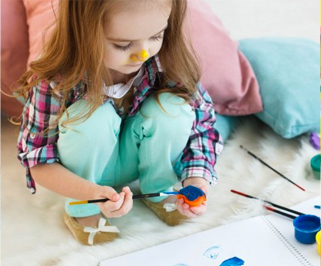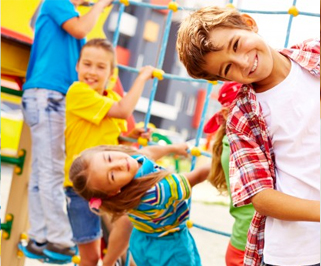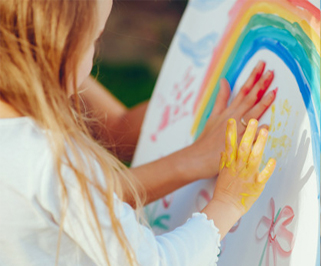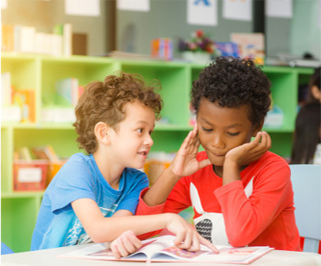Our philosophy
The Montessori School of Lasne has been offering an education based on the Montessori approach since 1999. This internationally renowned educational philosophy was developed by Dr. Maria Montessori. Dr. Montessori was the first woman to be awarded a doctorate in Italy, just over a century ago. Her training in medicine and science allowed her to work with children and observe them scientifically. Her observations sparked in her a deep interest in how these children learn.
In 1907, she founded a school for children aged two to seven. Maria Montessori was internationally recognized as an educator and was nominated for the Nobel Peace Prize. Today, there are over 8,000 Montessori schools worldwide, spread across every inhabited continent. The Montessori approach is the most widely used pedagogy in the world.
Dr. Montessori believed that education should not only take into account the academic aspect but should also provide support for life itself. Through her observations, she understood that children have particular sensitivities at different stages of their development.
By creating learning environments that match the needs and characteristics of children, they demonstrate a great capacity for concentration when carrying out their activities. Not only do they learn academic concepts with ease and enthusiasm, but they also develop self-esteem, self-discipline, respect for others and their environment, and adopt a calm and well-centered disposition.
Our basic principles
Maria Montessori puts the world in the hands of children. She always starts from a global perspective and then goes to the details
Maria Montessori Orientation
Maria Montessori did not ask herself what children should become when they are adults, she did not say to herself we need administrators for the State, nor workers for companies. Her primary concern was not to prepare today’s children for the needs of tomorrow. Her main concern was the needs of the child here and now. All her pedagogy starts from this first principle, rests on this basis.
The first basic principle of Montessori pedagogy is that of self-construction. Maria Montessori highlighted that the development of the human mind does not come from genetics, nor through speech, verbal, but that the child builds his mind himself. This often poses problems, worries, and a huge responsibility for us: this small child with such a huge responsibility, such a difficult task, how can he do it, how can we help him? The commonly accepted thought is that children do not know, cannot. How could this be possible?
But Maria Montessori starts from the principle that there is a vital force inside each child: Bergson’s “vital impulse”, also called “Horme” in French, which is both a vital impulse and a control.
Prepared atmosphere
“The child who incarnates from the experiences he has in the environment is a spiritual embryo that must live by itself in the atmosphere. But just as the physical embryo needs a specific atmosphere, the spiritual embryo needs to be protected from the outside, warmed by love rich in nutrients, an element where everything welcomes him and nothing hinders him.” Maria Montessori
It is up to the adult to prepare an environment adapted to the child because we live in a world artificially constructed for the adult, but what place do we make for the child?
If we want the child to be able to adapt to his environment, it is necessary that during his period of development the environment is adapted. Then perhaps the child will be able to be at the service of the environment.
A prepared environment must be:
Must constitute an invitation to activity, to movements that will contribute to the development of the child.
This environment will be respectful of the living environment.
This environment will be fixed, it will follow the child.
This environment must be maintained, we must maintain the possibility of working for the child because if the environment does not give the possibility of making efforts (work adapted to the child) then there is disinterest and disorder sets in. This is why it is not fixed.
The action on the atmosphere is indirect, we act on the child’s environment, we modify the environment that will bring him back to interest, therefore to the child’s development.
Atmosphere prepared according to age
The children’s house
In the children’s house, children work on tables adapted to their size and strength (they must be able to move the tables) individually and autonomously.
Children are interested in the name of things
Children aged 3-6 manipulate the material, they absorb the concepts, mechanisms and names.
Primary/elementary school (6-12 years old)
Children aged 6-12 prefer to work in groups.
Children are interested in the why of things; a simple name is no longer enough for them, they must understand the relationship between things, how they work, their role, etc.
Children therefore work with the material to be able to discover the why of things.
Age groups
Concepts:
Child development is not linear and continuous but is carried out by age group. Child development occurs through sensitive periods that differ according to age.
From 0 to 6 years
At this age, Maria Montessori speaks of the “Absorbent Mind”; the child absorbs his environment through his senses.
During this period:
the child acquires language(s)
the child acquires hand-eye coordination
the child absorbs the external order to build an internal order
the child is turned towards “his interest”
From 6 to 12 years
At this age, we can speak of “the Mind that understands”. The child is more physically developed and therefore many changes take place on the mental level.
During this period:
the child’s interest is turned outward
the child is therefore more social and is also interested in the interests of the group
the child is no longer satisfied with just names but also wants to understand the relationship between things.
Polarization of attention
Maria Montessori observed that children who self-construct in this way need a special atmosphere.
The child must be able to enter a state of very deep concentration: the state of polarization attention.
This deep concentration changes the child’s deep behavior: the negative effects go away, the child is happy, positive and harmoniously balanced.
Normalization
This process by which the child builds this balance was called “normalization” by Maria Montessori. All Montessori pedagogy is based on this principle. Children who are open to this vital impulse are able to change themselves: they become what Maria Montessori called “normal”; they develop according to what is right for them (“norm”).
“Normalized” children:
These children will have real joy in working.
These children are capable of very deep concentration, which can last beyond half an hour.
These children have respect and understanding for other human beings.
These children have an inner joy.
These balanced children will not need violent and destructive means to deploy their energy.
These children are less selfish and less possessive.
Our concern must be that these normalized and happy children learn everything they need to enter society and enrich it.
Cosmic Education
“Cosmos” is a Greek name and remains closely linked with Greek philosophy.
When we speak of “cosmos” we are talking about a universe made of order and harmony. Every little detail of the cosmos is part of a whole too, every detail is related to a whole; the smallest particle that surrounds us has a “role” in the harmony of the cosmos.
In “cosmic education”, every detail is important and every detail is related to a whole; there is a relationship between the different “subjects”. We should not think that “cosmic education” only includes history, geography and biology; it also includes mathematics (mathematics creates order), and language (language allows us to communicate, to transmit).
Just as all the little details of nature have a role to play in the cosmos, each human being has a role to play in this cosmos too, the cosmic task is to bring the child to discover his role in this cosmos for this, it is important that the child has the means to understand it.
Mix of ages
Maria Montessori insists on the importance of having different age groups in a class.
The different age groups promote good social development because it brings a group dynamic; the youngest are interested in what the older ones are doing and the older ones like to “help” the younger ones. By isolating children by age group, there is a lack of stimulation. Educators. It is wrong and out of fashion to think that the adult is at the source of the child’s development; the teacher must not place himself above the child but at “his service”. The teacher must not be at the center of things, he must work on the atmosphere.
The teacher puts the child in contact with the material; he invites the child to use the material through presentations. During these presentations, the teacher gives the concept to the child, the repetitive manipulations will lead the child towards a learning process and develop his cognitive abilities.
The teacher will ensure that the child is not disturbed during his work.
Importance of Montessori Pedagogy
The name “Montessori” is unfortunately not protected either, many establishments bear the name “Montessori” but do not always respect the “Montessori Spirit” also, as a Montessori teacher, it is important to respect all the genius of this pedagogy.
Scientific verifications
Not much scientific comparison research has been done on the merits of Montessori pedagogy, however all come to the conclusion that the education provided in Montessori establishments is superior to that provided in state schools.
Cosmic Education
“Cosmology ranks among the oldest intellectual disciplines of humanity. Although it is dedicated to the study of the Universe, of the cosmos encompassing the totality of what is accessible to us in nature, it has a specificity that distinguishes it from other natural sciences: it is only interested in the different parts that make up the Universe to the extent that they are related; and it is the set of these relationships, insofar as we can understand them, that best covers the concept of the Universe.”
“Cosmology is therefore not interested in objects in particular – planets, stars, galaxies, etc. – but rather in the framework in which they evolve, in the common laws to which they obey. It should be noted that the term cosmology has become widespread and encompasses what used to appear under the distinct names of cosmography and cosmogony. We will only deal here with scientific cosmology, the existence of which is based on a few more or less implicit principles.”
“Cosmic education”: Comes from the Greek cosmos which means the universe not in the chaotic sense but universe in the harmonious sense. The Greeks were philosophers and what interested them was to know what held the elements together in harmony.
These reflections on the cosmos were notably carried out by: Racines, Plato, Plotinus, Thomas Aquinas, Dante, Keppler, Comenius, Stoppani (uncle of Mr. Montessori. It is an interesting one whose reflections appear in the writings of Maria Montessori).
Concepts of cosmic education
It is important to take into consideration three aspects of cosmic education:
Give the universe to the child
Give the child the whole of nature by giving them a framework for reflection instead of giving them small details. We give them the whole before going to the detail; this is one of the logics of Montessori pedagogy. Start with an overview.
Once we have given this overview we will be able to give details but these details must always be related to the overview, we thus give a vision of the harmony that reigns in the cosmos. To keep this overview we must avoid keeping the subjects as part of certain branches of study. In cosmic education the branches no longer have a reason to exist. We have interdisciplinary teaching (all branches include each other) as a framework for the organization of the mind.
Showing the relationship between things
The Cosmos is a harmony in which the elements are interdependent. Children work with a mind that understands that cosmic education is particularly aimed at them; children are interested in the whole. Unfortunately this concept is not always accepted today. Traditional school continues to present branches whose interdependence is not presented at all.
In Montessori schools, the detail is part of a harmony and this harmony is only possible through the set of details that form a whole. So starting from the global does not mean having a superficial vision of the detail.
Cosmic tasks
An element of Maria Montessori’s theory is that all the details of the cosmos participate in the harmony of the cosmos. All segments of the universe contribute to the harmony of the universe.
Concept of finality: considers that everything advances towards a goal. This conception necessarily implies a universal intelligence that would direct operations towards a given goal. Maria Montessori shared this finalist conception, hence Cosmic Education; each element, each detail is part of a whole and for everything to work, each element obeys laws; the whole can only work because these details work together.
In nature: the cosmic task is unconscious
Photosynthesis: allows plants to develop, this results in changing carbon into oxygen, which allows other living beings to live.
Pollen: bees gather pollen from flowers and transport pollen from one flower to another, which allows plants to reproduce while activating their primary function: making honey.
At the human level: Man has a conscious cosmic duty and a number of animal cosmic duties:
– He breathes oxygen which becomes CO2 which will in turn be used by other elements such as plants.
– The role of man is to keep the earth alive.
– For Maria Montessori, only a high degree of education can contribute to maintaining international peace.
Knowing that all elements have a cosmic task, it is important for Maria Montessori that man takes his cosmic task into consideration.
Discipline and freedom
The Montessori method is based on freedom within an appropriate environment. Which, of course, does not mean that the child will be able to do what he wants, when he wants and how he wants.
To build himself, the child will draw from his environment. This is why he is constantly in “exploration movement”. Indeed, the child is not a passive container waiting for external knowledge. On the contrary, he will choose in his environment what will be useful for his development. To do this, he will be led to experiment by coordinating his movements, by collecting impressions in his environment thanks to all his senses.
It is the perfect organization of the environment which, leaving the individual the possibility of developing and spending his excess energy, provides each child with a soothing and salutary satisfaction. And it is in such working conditions that freedom leads to perfecting one’s activities, to reaching an accomplished form of discipline, itself resulting from this new quality of calm that has been duped in the child.
Freedom would be useless without the organization of work, and vice versa, it is the environment and manipulation that bring discipline. The word “discipline” can have several definitions, and the most common is to exercise control over another living being. However, we prefer Maria Montessori’s vision of an active discipline. The child will acquire discipline and respect social laws, through his experiences in an appropriate environment.
The child has the freedom to move around the classroom as he pleases, and to choose to use and repeat an activity individually. Through this “free manipulation” of the material, the child will acquire a certain inner discipline that will manifest itself through self-confidence and self-control. This constitutes a new step towards independence. The child will have respect for himself and for his work, for his environment, and for other children.
All the conditions are thus met for collaborative work (cooperation is essential in social life). We therefore see the need for a prepared environment. How is this established?
1) Clear limits
These internal rules of the individual are not known to the young child. The gradual assimilation of these rules will be done by the child thanks to the adult who guides him, instead of imposing them on him. The child’s mission in life is to become an adult.
To accomplish this mission, the child needs freedom to develop, to think, to question, to move, to explore, to make decisions and to bear the consequences; all this within a framework with strict and reasonable limits. These will constitute benchmarks for the child, hence the need for order.
The child will know exactly where he is, instead of being lost in an ocean of confusion.
Be consistent and coherent
The child will quickly understand and play on the fact that we are sometimes convinced to say “yes”, because it is easier. The adult is a point of reference for the child, and thus gives security to the child. The adult must sincerely believe in the limits established and represent them. “Dare to say no” Likewise, when the child makes a decision, he must suffer the consequences. The adult must “take action” to apply these consequences.
The tone of our voice and the expression on our face
must correspond to the order given “don’t do that, please, my dear” said in a soft voice and accompanied by a smile, gives contradictory messages to the child. It is not necessary to shout, but to speak firmly, seriously, and to show real displeasure with the act in question.
Phrases and vocabulary used
The construction of an order can install an internal or external obedience. It is important that the child knows that he is doing something for his personal construction.
“Can you put your shoes on, please” is different from “can you put your shoes on for me, please?”. Similarly, “What you did was good / bad!” is very different from “you are good / bad”. A child should not become bad by committing an undesirable act.
Punishments and rewards
They are useless. They only temporarily alter specific attitudes; they do not teach self-confidence, self-discipline; they do not encourage creativity and collaboration. They do not fool the responsibility in the child, but their use discourages the child. This is why they must be replaced by an approach that emphasizes the child’s inner control and individual responsibility.
To rewards, the child prefers the feeling of belonging and contributing to something, by having behavior of usefulness, help, responsibility and collaboration.
We must respect and build on this desire by providing opportunities for expression, rather than distorting it by offering rewards or threatening punishment.
2) Understand your child
– Why is he doing something that we don’t like right now? For example, we ask the child to try to put on his shoes without our help. We turn around to see that he has taken off his laces and we are late.
When picking up his shoes, the child noticed the laces. It is interesting to see how to take them off, and how to put them back on alone.
Give the child time to discover and learn.
– We must also adapt our explanations to the child’s age and/or level of understanding. Young children need short and firm orders.
– Gradually add reasons, explanations using simple language, while keeping it short.
– If the child wants to know more, he will ask every time, you have to be careful to answer simply the question asked.
– It is less likely that the child will question something if he thinks that we are going to launch them into an endless speech!
3) Freedom to make mistakes
Will allow the child to actively learn for his efforts, and to correct himself.
– Show him
It is normal to make mistakes, and we learn from these mistakes.
If we make a mistake, we can point it out to the child, and show him how to solve it. “Oh I spilled juice. It’s not serious, I’ll clean it up. Will you help me?”.
Example
Children see and hear everything, even if they don’t seem to.
When we are with children, it is important to set an example
But at the same time they quickly understand if we are not sincere.
To conclude, if we give a child the freedom to say “no”, to discover and explore, to make mistakes, to learn through logical consequences in a stable environment with reasonable limits, we will be able to discover an independent, autonomous, attentive and disciplined child, with the freedom to think for himself and to develop.
The greatest gift a child can receive!
The teachers
A different training
The role of the Montessori teacher differs considerably from that of the traditional teacher. The Montessori teacher observes the child according to his or her own needs and interests. Her training allows her to recognize sensitive periods during which the child will learn one concept rather than another with ease while showing him or her the appropriate use of the teaching materials.
Observe
Sometimes, the teacher will encourage the child who is a little hesitant by using positive reinforcement. At other times, he or she will guide a child who chooses an exercise with which he or she will not have success towards an exercise appropriate to his or her abilities, interests and needs.
Protect
The Montessori teacher protects the integrity of the child and helps him or her to make his or her choices freely. The child is influenced by the behavior of the teacher who must be both firm and consistent, patient and gentle.
Highly qualified
The training that the teacher has followed allows him to deepen his general knowledge of the child and his development.
Teachers who have received Montessori training are initially highly qualified and undertake their teaching career as a vocation and a mission to serve the child.
Goals and objectives
The primary goal of a Montessori school is to provide children with a stimulating learning environment that will allow them to acquire an excellent basic education while promoting creativity and full personal development.
In a Montessori school, the teaching tools aim to provide a wide choice of experiences for children and to promote the development of reasoning. The activities in the program are fascinating for young children because they encourage sensory exploration and repeated manipulation of materials. When engaged in well-structured work, the child feels a deep and positive inner satisfaction.
The Montessori school aims to develop the following skills and characteristics:
Develop in each child a positive attitude towards school
Almost all learning activities are individualized. Children do work that has a particular appeal for them and they discover activities designed to meet their needs and level of maturity. They learn at their own pace while repeating the same exercise as often as they want to gradually achieve many successful accomplishments.
Develop self-confidence and self-discipline
Lack of self-confidence is often the root cause of academic difficulties for primary and secondary school students. At the Montessori school, work is presented in such a way that each new step that is reached by the child is based on what he has already mastered in his previous exercises. This way of proceeding considerably increases a child’s chances of success and minimizes the risk of failure. Thanks to their successes, children become more confident and realize that they are able to learn on their own. These activities also contribute to healthy emotional development in the child.
Develop concentration
For learning to be effective, the child must be able to listen attentively and follow instructions. The child gradually increases his power of concentration through a series of captivating experiences.
Encouraging constant curiosity in children
Rapid changes in society encourage us to be lifelong learners. A deep and constant curiosity is essential for creative learning. We stimulate curiosity and the natural desire to learn in children by providing them with ways to discover, qualify, explore and establish relationships applicable to all learning situations.
Developing initiative and perseverance
In a Montessori environment, children are surrounded by attractive materials adapted to their needs. Learning activities are personalized and allow the child to repeat a task as often and for as long as he wishes. The instructions are clear. All these elements promote initiative and perseverance in children.
Encouraging well-being and order in children
A child feels calm, serene and safe in a rich, simple and orderly environment. In a Montessori classroom, children’s innate need for order is fully satisfied since each item has its place and there is a place for each item. In this secure environment, the child will gradually develop a certain discipline and inner security necessary for healthy and serene emotional growth.
Developing sensorimotor skills
The development of sensorimotor skills is stimulated through the manipulation of a variety of materials that have proven themselves over the years. This didactic material was designed and created following the discoveries of Dr. Maria Montessori as well as the conclusions of modern psychology. It is by accomplishing tasks that require the refinement of gross and fine motor skills that the child acquires better control of his movements. The muscular movements performed in many of the tasks and exercises in class are in fact an indirect preparation for writing.
Stimulate judgment and sensory discrimination
Children are invited to do sorting and assembly activities that allow them to recognize similarities and identify differences in size, shape, color, texture, smell, sound, etc. It is important to stimulate children’s sensory acuity because their ability to describe the world is proportional to the refinement of their senses.
Help children develop socially
It is by working with other children that each child learns not only to cooperate, but also to inhibit certain behaviors that could be detrimental to others. The child gradually learns to adjust his or her needs to those of others and to develop respect for others.
Developing Creativity and Imagination
Through stimulating activities, we encourage children to express and practice their learning experiences. We provide opportunities for self-expression through movement, oral expression, and artistic expression. Practical life exercises, sensory materials, mathematics, music, art, language, and science provide the foundation for creativity.
In short, the Montessori approach aims to help each child develop good work habits, a positive attitude, skills, and ideas that will be essential to their learning throughout life.
Decalogue of the educator
According to Maria MONTESSORI
- Never touch the child unless he invites you to (in one way or another).
- Never speak ill of a child in front of him or in his absence.
- Concentrate your effort on reinforcing and helping the development of what is positive in the child.
- Put all your energy into preparing the environment, take care of it regularly in a meticulous way. Help the child to establish good relations with the environment. Show him where the material is stored and indicate to him how he must use it.
- Always be ready to answer the call of the child who needs you, always listen and answer the child who has recourse to you.
- Respect the child who makes a mistake and who can, either in the moment, correct himself, but firmly and immediately stop any misuse of the material and any action that endangers the child, his development, or other children.
- Respect the child who rests or watches others work, or reflects on what he has done or will do.
Do not call him or force him into another form of activity. - Help those who seek an activity and do not find one.
- Tirelessly present activities to the child who has refused them before; help him constantly to acquire what he does not yet have and to overcome his imperfections, do all this by animating the environment with care; by deliberately having a reserved attitude, by using kind words; and by being a loving presence. Make your presence and your availability felt by the child who is seeking, and remain hidden from the one who has already found.
- Always treat the child with the utmost politeness and offer him the best that you have.
Secular education
The teaching provided by Montessori Kids is secular, which means that no discrimination of a religious or racial nature will be practiced by the school, nor tolerated on the part of the child or parents, whether at the behavioral, medical, nutritional or other level.
The school aims to be international and takes advantage of all these cultural riches brought by each child and parent to share and better understand the culture, religion and customs of each.
